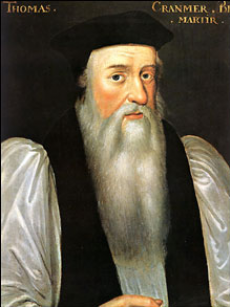
Email: EllaTournes@bexleygs.co.uk
Total Article : 45
About Me:Sixth form student currently studying English Literature, Drama and Theatre Studies, Classical Civilisation and History.

In terms of historiography, Duffy, a revisionist historian, places a lot of emphasis on the role of Cramner in changes to Tudor Religion. He claims that ‘(Cramner was) the key figure in the shaping of the English Reformation, his successive version of the Book of Common Prayer gave the reformed Church of England its distinctive liturgical and devotional ethos’. The phrases ‘key figure’ ‘successive’ and ‘distinctive’ all suggest the importance of Cramner. The fact that Duffy claims he is ‘the key figure in of the English Reformation’ also support the argument that the religious changes made under Edward were the most significant, as Cramner’s most active period as a theologist was during this period.
Haigh, however, suggests that Somerset’s role was more crucial to the Reformation (even if Somerset himself is not painted in a particularly flattering light). Haigh says that ‘Somerset himself had evangelical inclinations, and he cultivated a Protestant mode; he ran a Protestant household’. The idea of Somerset ‘(running) a Protestant household’ (i.e. the King’s household) emphasises his power over the King, and other the country. Haigh, does, however, accuse Somerset of being easily influenced ‘Somerset had not dashed headlong into reform, but pressures from Protestant enthusiast and financial necessities had pushed him to dangerous innovations’. This maybe suggests that the pace of the Restoration, which he so highlights, was not the result of the government behind the reign of Edward VI, but from external pressures.
It is important to consider the fact that Edward wasn’t the only Tudor monarch who was influenced by other people. Thomas Cromwell played a heavy part in the Break from Rome, orchestrating an evangelical and reformist course that allowed Henry VIII his annulment to Catherine of Aragon, and allowed him to stop the flow of taxes and money into Rome. He was arguably the ‘presiding genius’ (Elton, The Tudor Revolution) of the Reformation. He aimed to try and clarify religious doctrine, and heavily opposed idolatry (he dismantled the shrine of Thomas Becket). As Cromwell seemed to orchestrate most of the ideas of the Reformation, it could be argued that the most significant changes towards religion were made during the time he was active. However, he met stronger opposition than Somerset or Cramner did – most notably by the likes of Cardinal Wolsey and Thomas More. Mary I was also influenced by other people – in particular, Stephen Gardner (who was appointed Mary’s Chancellor, and took a leading role in the return to Catholicism and the restoration of Roman doctrine) and Reginald Pole (who negotiated a papal dispensation, enabled the Revival of the Heresy Acts and was consecrated as Archbishop of Canterbury), as was Elizabeth, by her Grindal, and (more so) by John Whitgift, who became Elizabeth’s chaplain in 1563 – a position that gave him access to, and influence over the Queen. He produced his ‘Three Articles’, which trapped religious non-conformists. All of the Tudor monarchs were affected by the people that influenced and advised them – however, none had almost regal power in the way that Somerset and Northumberland did, due to the monarch’s ages. That’s not to say that their influence wasn’t equal or greater – it just had to be a lot subtler.
Source: http://www.luminarium.org/renlit/cranmerbio.htmL

0 Comment:
Be the first one to comment on this article.